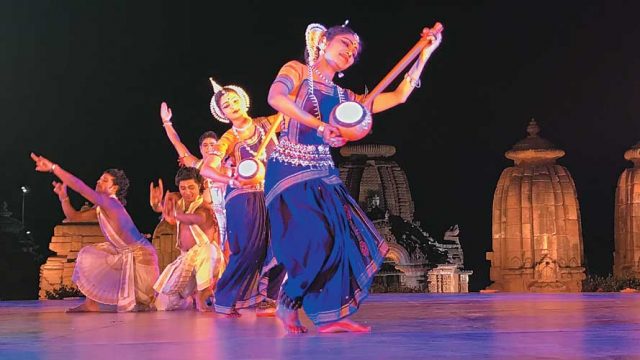One of the most significant contributions of Odisha to Indian culture and classical dance is Odissi. Witnessing it being performed against a backdrop of ancient temples is to witness beauty and poetry in motion. Odissi dancers don traditional silks, filigreed silver jewellery and tinkling bells called ghungroos on their feet. A crown of flowers or peacock feathers, which resembles a temple spire, frames their hair bun. An Odissi dancer can mesmerise you with her gazelle-like movements, striking poses, and a glance of her expressive kohl-rimmed eyes.
The celebration of dance and music is imprinted in the landscape of Odissa since time immemorial. Odissi emerged in Hindu temples as a Devadasi tradition (a religious practice where parents marry their daughter off to a temple or deity) over 2,000 years ago. Archaeological sites associated with Hinduism, Buddhism and Jainism display sculptures and inscriptions showcasing the role of music and dance.

Odissi is characterised by tribhangi, a concept that divides the human body into three parts (head, bust and torso), and the postures that deal with these elements. The exaggerated movements of the upper torso are reminiscent of waves, the graceful fluidity of the mudras or gestures mimic the swaying palm trees and the strong thump of the feet simulate the heartbeat of Mother Earth. The ashtapadis (poem of eight couplets) of Jayadev, the legendary 12th- century Sanskrit poet, is a common theme, while the depiction of the eternal love of Radha-Krishna from his epic poem Gita Govinda is fundamental to the abhinaya (expression) in Odissi dance. Besides popularising the classic tribhangi (threefold) posture of Krishna playing the flute, Jayadev also institutionalised the Devadasi system in Oriya temples, which had a separate nata mandir (dance hall) for performances.
Bas reliefs at Udaygiri depicting shapely dancers prove that dance was actively encouraged as early as 1st century BCE. Recorded as Odra Magadhi and rooted in the principles of Natya Sastra, the sacred Sanskrit treatise on the performing arts, Odissi developed in the Mahari tradition and received royal patronage between the 6th and 11th centuries. At one point in time, even members of the royal family were accomplished dancers, which spawned the Nartaki tradition.
Sadly, the journey of this art was tumultuous. The invasion by Mughal armies and the plunder of temples led to the decline of Odissi. The incursion by Sultan Firoz Shah Tughlaq (1360–61) damaged several dancing statues and nata mandirs, including the one at the Jagannath Temple in Puri. Dancers were reduced to entertainers or nautch girls in the courts and concubines of royal families.

In the 17th century, Odissi regained some of its former glory under the patronage of king Ramachandradeva, who promoted the arts and the spread of Vaishnava philosophy in Odisha. Dance was encouraged even amongst young men, and it broke away from the norm of being an art form only for women. This gave rise to the Gotipua tradition of Odissi, where young men dressed like women and performed on stage.
Unfortunately, British officers and Christian missionaries launched an ‘Anti-Nautch’ movement in 1892, discouraging financial support to the dance form, and banned the practice of dancing in temples. However, some nationalists sparked off a revivalist movement. After Independence, artists and performers came together to restructure various classical arts. Odiya poet, researcher and dramatist Kavichandra Kalicharan Pattanayak is credited for naming the dance form of Odisha as Odissi.
Since the 1940s, Odissi has grown into a renowned art form performed throughout the world. In recent years, dance festivals organised at Bhubaneswar, Puri and Konark have exposed Odissi to a wider audience.




